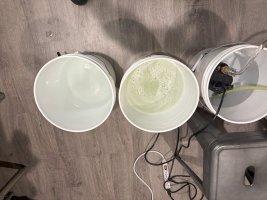Thanks All... all these comments, and especially
@mac_1103 's last one have generated some more questions:
Not only do all our taps see very different usage from one member to the next, we may all be using different tubing as well...
When I set up my first kegerator, I used Bevlex 200. In the begining, I read on here to see how often others cleaned beer lines and for the first few kegs I just flushed them out with hot water and Star San, but after those first few kegs I could see the tint of a veneer forming in the lines so I flushed, let sit, and flushed some more with hot PBW and it came up looking like new... I was happy. When I upgraded to 4mm ID EVABarrier I initially used the same routine with every keg change. I can't remember how long I had the 4mm before I swapped it out for 3mm ID EVABarrier at the end of 2023, but since that time I continued using PBW until last year on one particular line: Until about a month ago, I kept repeats of the same stout so I thought I'd experiment: Instead of PBW I simply rinsed the lines with hot water between each 2.5 keg batch. I keep a short length of brand new 3mm ID EVAbarrier which I hold up to the line in use and compare with light shining through and after nearly one year, there was no sign of buildup, no off-tastes. ....Oh; I am the only one drinking this in my house, so it takes a while to finish a batch. I recently swapped out for an Irish Red, so I PBW cleaned the line again finally and on inspecting the flush, it was spotless...I was actually surprised.
I'm wondering: Does EVABarrier have greater resistance to build-up? Given it's lower permeability it sounds like it might, but that's not scientific so it's not an answer at all.
Is there a noticable difference that others have seen between heavy and light use lines?.. between EVABarrier and other tubing?







































![Craft A Brew - Safale BE-256 Yeast - Fermentis - Belgian Ale Dry Yeast - For Belgian & Strong Ales - Ingredients for Home Brewing - Beer Making Supplies - [3 Pack]](https://m.media-amazon.com/images/I/51bcKEwQmWL._SL500_.jpg)


















